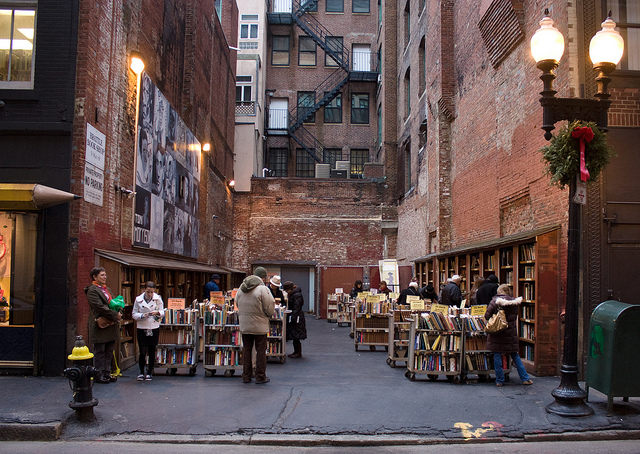Unlock the Magic in Your Story Now
Get the Free 20 questions to Ask Before Launching Your Idea workbook when you sign up for occasional updates.
Get the Free 20 questions to Ask Before Launching Your Idea workbook when you sign up for occasional updates.
What Are Your Words Designed To Do?
filed in Marketing, Storytelling
 How often have you read website or marketing copy that uses words we’d rarely use in conversation? The real estate agent’s copy describing homes as abodes or residences. The jargon in the consultant’s brochure. The officious tone of the notices in the dentist’s waiting room. We’re often left wondering if the purpose of the language is to confuse when it should be to connect.
How often have you read website or marketing copy that uses words we’d rarely use in conversation? The real estate agent’s copy describing homes as abodes or residences. The jargon in the consultant’s brochure. The officious tone of the notices in the dentist’s waiting room. We’re often left wondering if the purpose of the language is to confuse when it should be to connect.
Before you sit down to craft your marketing messages, it’s worth asking yourself what the words are designed to do. Are you inviting a customer to take action or hoping to persuade a doubtful audience? Are you galvanising your team around a shared goal or getting to know your customers better?
7 Questions To Guide Effective Content Creation
1. What does the audience already know?
2. What does the audience need to know and why?
3. What do you want the audience to do next?
4. What specific language, tone and calls to action do you need to use?
5. Is the copy relevant, clear and credible?
6. What’s the best medium to use in order to reach this audience?
7. How will you measure the effectiveness of your messages?
Clever copy shouldn’t simply make the writer appear smart; it should make the reader feel understood. Words are free, and they are the most potent resource every one of us has access to.
Image by Eka Shoniya.
Share this article
More Than
filed in Marketing, Storytelling
 In hard-headed, rational commercial environments where tangible advantages are sought in order to make the books balance, we often overlook the value of our products and services being more than commodities. Everything a customer chooses to exchange time, attention or money for says something about who they are. Purchases are forms of self-expression. What we choose to invest in or own is an outward reflection of our internal narrative about who we are and what we value.
In hard-headed, rational commercial environments where tangible advantages are sought in order to make the books balance, we often overlook the value of our products and services being more than commodities. Everything a customer chooses to exchange time, attention or money for says something about who they are. Purchases are forms of self-expression. What we choose to invest in or own is an outward reflection of our internal narrative about who we are and what we value.
The product you’re trying to market is more than the sum of its features and benefits. For example, a car becomes more than a car when it’s part of the driver’s story. The car my husband drives is a ten-year-old, 1.1 litre Yaris with hundreds of kilometres on the clock. We bought it when we moved to Australia and shipped it interstate when we relocated. All three of our boys learned to drive in that little car. For better or worse, I don’t see us parting with the Yaris anytime soon.
The goal of every innovator and marketer is to create the thing that is not just more reliable or useful, but the one that is more meaningful in the life of the customer than he expected it to be.
Image by Bass n’ Roll.
Share this article
Change Making
filed in Storytelling, Strategy
 The story changes the value.
The story changes the value.
The value changes the perception.
The perception changes the experience.
The experience changes the outcome.
The outcome changes the customer.
The customer changes the story.
Image by Matthias Ripp.
Share this article
The Power Of Perspective
filed in Storytelling, Success
 The brilliant science graduate had a decade of first class education behind her. But the industry she thought she’d been equipping herself to excel in was experiencing a sudden downturn and her hope of finding the work she had trained to do. Her excellent academic record and transferable skills were worthless in the face of the story she told herself about the future.
The brilliant science graduate had a decade of first class education behind her. But the industry she thought she’d been equipping herself to excel in was experiencing a sudden downturn and her hope of finding the work she had trained to do. Her excellent academic record and transferable skills were worthless in the face of the story she told herself about the future.
Hope impacts our internal narrative, acting like the aperture of a camera’s lens controlling the amount of light reaching the film. It makes us more resourceful, fuels our resilience and strengthens our resolve. We might not have the ability to alter the scene but we can change our perspective.
We have more power to shape our stories than we realise.
Image by Elizabeth Haslam.
Share this article
Getting There
filed in Success
 In my mother’s day, ‘getting there’ meant finding a partner, having a roof over your head and family you could afford to feed. That’s still the reality for many but probably not for most people reading this today.
In my mother’s day, ‘getting there’ meant finding a partner, having a roof over your head and family you could afford to feed. That’s still the reality for many but probably not for most people reading this today.
Now ‘there’ is now the elusive place where accomplishments are built ever higher, boxes are ticked and accolades rain down. A transient state of worthiness we achieve when we finally have proof that we’ve done enough, achieved enough, been enough. ‘There’ is a metric that quickly loses it’s shiny allure once it’s met. A journey we are encouraged to feel we should be on and a destination where many of us will never feel we’ve quite arrived.
The truth is we are ‘there’ in every moment we live without comparison, or spend our time wisely. When we give of ourselves generously and create intentionally. It’s not some distant or better horizon, but a grounded state we can give ourselves permission to inhabit.
You’re already there if you choose to be.
Image by Stephanie Onderchanin
Share this article
How Our Actions And Results Align
filed in Entrepreneurship, Success
 If we want attention, we must deliver value.
If we want attention, we must deliver value.
If we want to be innovative, we must practice empathy.
If we want loyalty, we must give respect.
If we want to be believed, we must earn trust.
If we want rewards, we must embrace risks.
If we want to matter, we must create meaning.
We not only reap what we sow but also how and why we sow.
Image by carnagenyc
Share this article
The Potential Downside Of Maximizing
filed in Strategy
 There’s a great cafe in East Melbourne where you can order half a sandwich. This addition to the menu seems trivial, but it tells us a lot about the values of the cafe owner. He knows that a peckish diner will order the whole sandwich and leave what she doesn’t want. Of course, this would generate more revenue for his business, but also waste food and sometimes induce guilt in his customer. This generous posture that gives rise to the half portion gesture doesn’t go unnoticed. The cafe hums with regular customers and benefits from repeat business, goodwill and word of mouth.
There’s a great cafe in East Melbourne where you can order half a sandwich. This addition to the menu seems trivial, but it tells us a lot about the values of the cafe owner. He knows that a peckish diner will order the whole sandwich and leave what she doesn’t want. Of course, this would generate more revenue for his business, but also waste food and sometimes induce guilt in his customer. This generous posture that gives rise to the half portion gesture doesn’t go unnoticed. The cafe hums with regular customers and benefits from repeat business, goodwill and word of mouth.
It’s tempting to squeeze out every dollar, fill every moment and exploit every advantage, but there’s usually an opportunity cost to doing so—a compromise that needs to be made as a result. In our drive to maximise efficiency, profits and productivity we often miss the chance to do what’s right, to notice significant details or to amplify the thing we do well.
Maximizing can lead us to focus on short-term gains instead of a vision for the future or to sacrifice what’s important for the sake of growth. More and better are not always an indication of having achieved the right outcome. The strategy of ‘enough’ can allow us to focus and flourish. In the end, it’s not possible to go in every direction. We have to choose the path worth taking and then decide how to show up on it.
Image by Postcards Inside.
Share this article
Making Your Mark
filed in Entrepreneurship, Storytelling
 Making a mark is not something we talk openly about that much, but it’s something we think about a hell of a lot. From the grandmother who hands down her legendary Christmas pudding recipe, to my Uber driver who, despite having held a managerial position with a big retailer for sixteen years, ‘wants to build something of his own’. From the street artist who feels like he has no voice, to the financial planner who wants to teach the next generation of children how their small actions today can impact their future.
Making a mark is not something we talk openly about that much, but it’s something we think about a hell of a lot. From the grandmother who hands down her legendary Christmas pudding recipe, to my Uber driver who, despite having held a managerial position with a big retailer for sixteen years, ‘wants to build something of his own’. From the street artist who feels like he has no voice, to the financial planner who wants to teach the next generation of children how their small actions today can impact their future.
The fear that we might run out of time to make our mark is one of the reasons we strive to get better at telling our stories. But if the truth is what’s at the heart of all great stories, we can’t begin to make a mark until we acknowledge and articulate what we’re really here to do. Once you’re honest with yourself about the real work you care about and why, you can begin to unapologetically make the mark you hoped to make.
Image by Steffi Lange.
Share this article
How To Learn From The Customer Journey
 Many of the businesses you will frequent today have no idea how you became a customer. What’s worse than not knowing what brought you there is either making an incorrect assumption or not having an interest in your journey at all. It’s easier than ever in an online world to understand where customers come from, but if we want to create and grow sustainable businesses, we also need to pay attention to what they do and why they come.
Many of the businesses you will frequent today have no idea how you became a customer. What’s worse than not knowing what brought you there is either making an incorrect assumption or not having an interest in your journey at all. It’s easier than ever in an online world to understand where customers come from, but if we want to create and grow sustainable businesses, we also need to pay attention to what they do and why they come.
Whether your business operates online or offline it’s possible to get better at learning from the customer’s journey. Every day I see people walk into delis, boutiques and bookstores to browse, sometimes they leave without buying anything, but they always leave clues as to the purpose of their visit, their mindset or worldview. For example, consider the shopper who whips out his smartphone to snap a photo at the local bricks and mortar store to keep a record of the things he’d like to research or order online later.
Questions To Consider About The Customer Journey
1. What prompted the customer to visit today?
2. Where did they hear about you?
3. What did they look at, browse, pick up or buy?
4. Why did they buy?
5. What did they browse, pick up and not buy?
6. Why didn’t they buy?
7. Why were they researching or shopping?
8. How could you fulfil their needs and wants in the future?
9. What might make them return?
10.How can you create opportunities that enable you to get to know them better?
What we learn from our customers’ actions and reactions teaches us where best to focus our energy and why. Curiosity is an underrated business resource.
Image by Toshihiro Gamo.
Share this article
Understanding The Value Gap
 You may have noticed how commonplace complimentary gift wrapping has become this festive season. In years gone by this service was offered by bigger department stores or as a fundraiser for charities in local shopping centres. This year though it seems that every retailer from the bookstore to the pharmacy has decided that complimentary gift wrapping might just be a way to differentiate. If the bricks and mortar retailer can’t be more convenient or cheaper, then it stands to reason that they need to add another service layer to their offering to address the perceived value gap. But just as the scripted, ‘have a great Christmas’ greeting you’ve heard the checkout operator repeat ten times before you reach him rings hollow—when everyone uses the same low-risk value adding strategy no experience feels authentic or unique.
You may have noticed how commonplace complimentary gift wrapping has become this festive season. In years gone by this service was offered by bigger department stores or as a fundraiser for charities in local shopping centres. This year though it seems that every retailer from the bookstore to the pharmacy has decided that complimentary gift wrapping might just be a way to differentiate. If the bricks and mortar retailer can’t be more convenient or cheaper, then it stands to reason that they need to add another service layer to their offering to address the perceived value gap. But just as the scripted, ‘have a great Christmas’ greeting you’ve heard the checkout operator repeat ten times before you reach him rings hollow—when everyone uses the same low-risk value adding strategy no experience feels authentic or unique.
It would be easy for retailers to panic in the wake of Amazon’s plans to reimagine the bricks and mortar shopping experience with Amazon Go. But it’s important to understand that there are as many reasons why people shop as there are to add value. Convenience, price and even service add-ons are only part of the value story. If we’re to truly differentiate our offerings we have to dig deeper and consider the value gap we’re hoping to fill for exactly what kind of customer. The good news is that not everyone wants to grab and go. There are people who want to shop locally or sustainably, and those who care about human connection more than the lowest price. You don’t have to market to everyone, but you do need to know the someone you’re filling the value gap for and what matters to them.
Image by Bill.